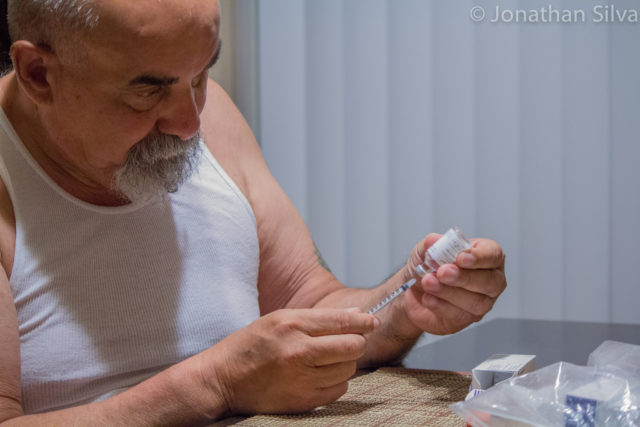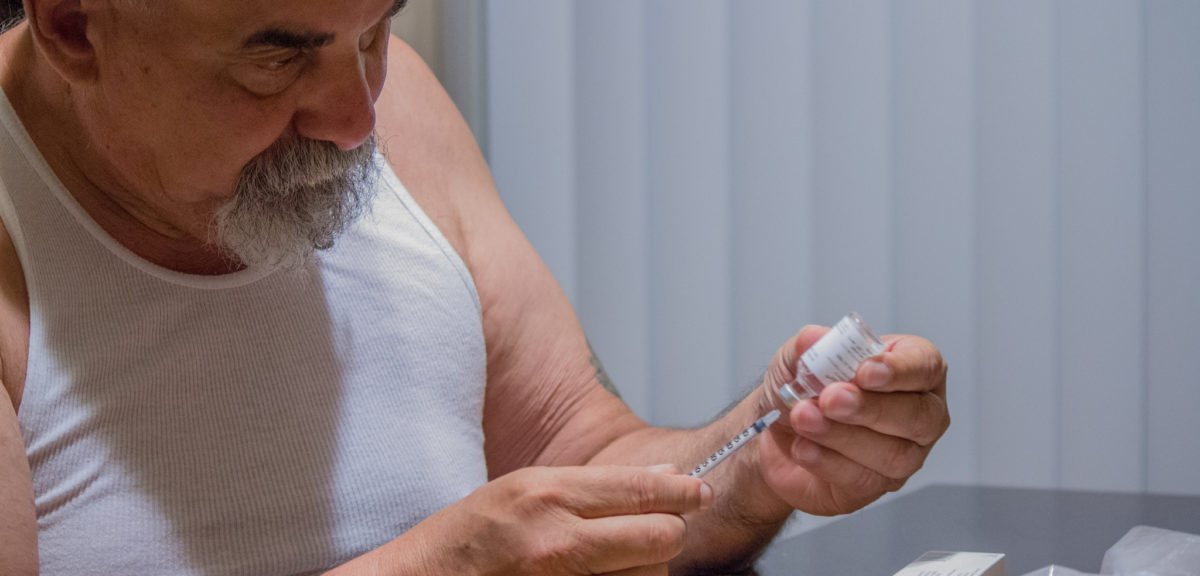
The dark galaxy Dragonfly 44. The image on the left is a wide view of the galaxy and a close-up on the right. The massive galaxy consists almost entirely of Dark Matter. (Pieter Van Dokkum, Roberto Abraham, Gemini, Sloan Digital Sky Survey)
Galaxy Made-Up of Mostly Dark Matter Discovered
A team of astronomers, using two of the world’s most powerful ground based telescopes, have discovered an enormous galaxy that’s only .01 percent visible.
The remaining 99.9 percent, according to the astronomers, is made up of dark matter.
The faint galaxy is called Dragonfly 44.
It’s located within the Coma cluster, about 321 million light-years from Earth, and is nearly 70 thousand light-years across.
To make their discovery, the astronomers used the W. M. Keck Observatory and the Gemini North telescope, which are both on Maunakea, Hawaii.
A spectrograph, a device that splits light into separate wavelengths, called DEIMOS was installed on the Keck Observatory’s Keck II telescope to help astronomers calculate the amount of dark matter in the galaxy.
Dark matter, a so-far unknown type of matter that we can’t see, is thought to make up about 27% of the observable universe.

Diabetic patient prepares a dose of insulin for injection (JonathanSilva via Flickr/Creative Commons)
Ouchless Insulin for Diabetics
The International Diabetes Foundation predicts that one in ten people will have diabetes by 2040.
Treatment for diabetes can include one or two painful injections of the hormone insulin every day.
Now, scientists at Niagara University in New York say they’ve developed an ideal transport system that can withstand some of the harsh environments of the human body and effectively deliver insulin where it needs to go without the need for those painful shots.
The insulin is contained in a small capsule, called Cholestosome™, which is made of naturally produced lipid molecules or fatty acids.
After testing in rodents, the researchers found the capsules can travel undamaged through the digestive system and then cells in the bloodstream take them in, break them apart, and release the insulin.
The researchers presented their findings at the 252nd National Meeting & Exposition of the American Chemical Society in Philadelphia.

Aliens? (Interdimensional Guardians/Creative Commons)
Search for ET Shifts to Lower Frequency Range
For years, professional and amateur astronomers have been examining the skies with radio telescopes, searching any signs of extraterrestrial intelligence, or ETI.
Scanning UHF radio frequencies, mostly between 1.4–1.7 GHz, scientists carefully listen for any distinctive signal that might emerge from the background noise.
Lately scientists are focusing on a lower frequency range, between 80 to 300 MHz, to look for ETI.
The Murchison Widefield Array or MWA radio telescope, located in Western Australia, has been built by an international group of universities to specifically hunt for ETI signals in this frequency range.
Initial observations of a small piece of the sky and a limited range of frequencies yielded no ETI signals.
But the scientists at the MWA are planning future observations that will cover the full sky at the full frequency range. What if anything will they hear? We will stay tuned, so to speak!

Enjoying a sweet dessert (typexnick via Flickr/Creative Commons)
Device Helps Bland Food Taste Good
A diet containing less fat, sugar or salt is often recommended to many to ensure good health.
But the downside of those diets might mean having to eat foods that really don’t taste that good.
Now French scientists say they are working on a device that could help diners on restrictive diets enjoy the full flavor of their favorite foods and still eat healthfully.
The device, they call the Gas Chromatograph-Olfactometry Associated Taste (GC-OAT) allows scientists to isolate specific aroma molecules associated with the full flavored food.
When you eat, your taste buds allow you to sense sweet, sour, salty, bitter and savory tastes. But it’s the smell of the food that completes your perception of its taste.
The scientists say that by applying the proper amount of these aroma molecules in food, the brain can be fooled into thinking there is more salt, sugar or fat than what may actually be present in that very healthful food you are having for lunch.























Comments are closed.